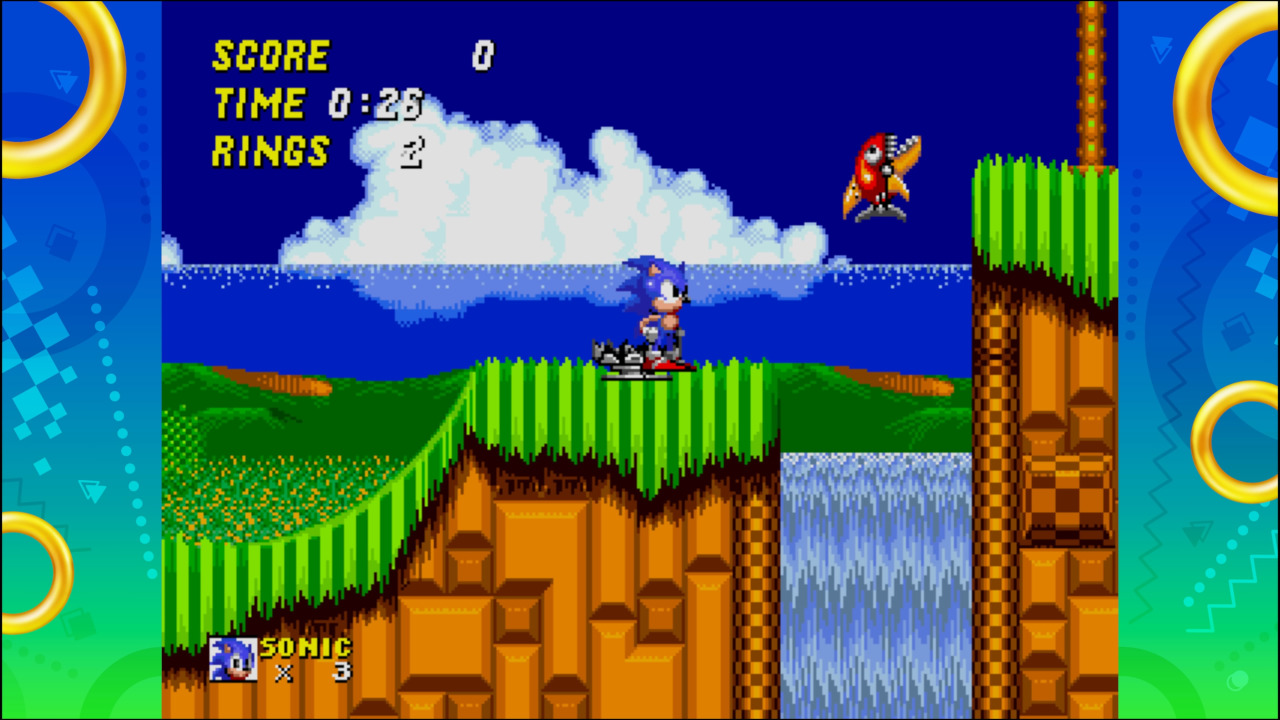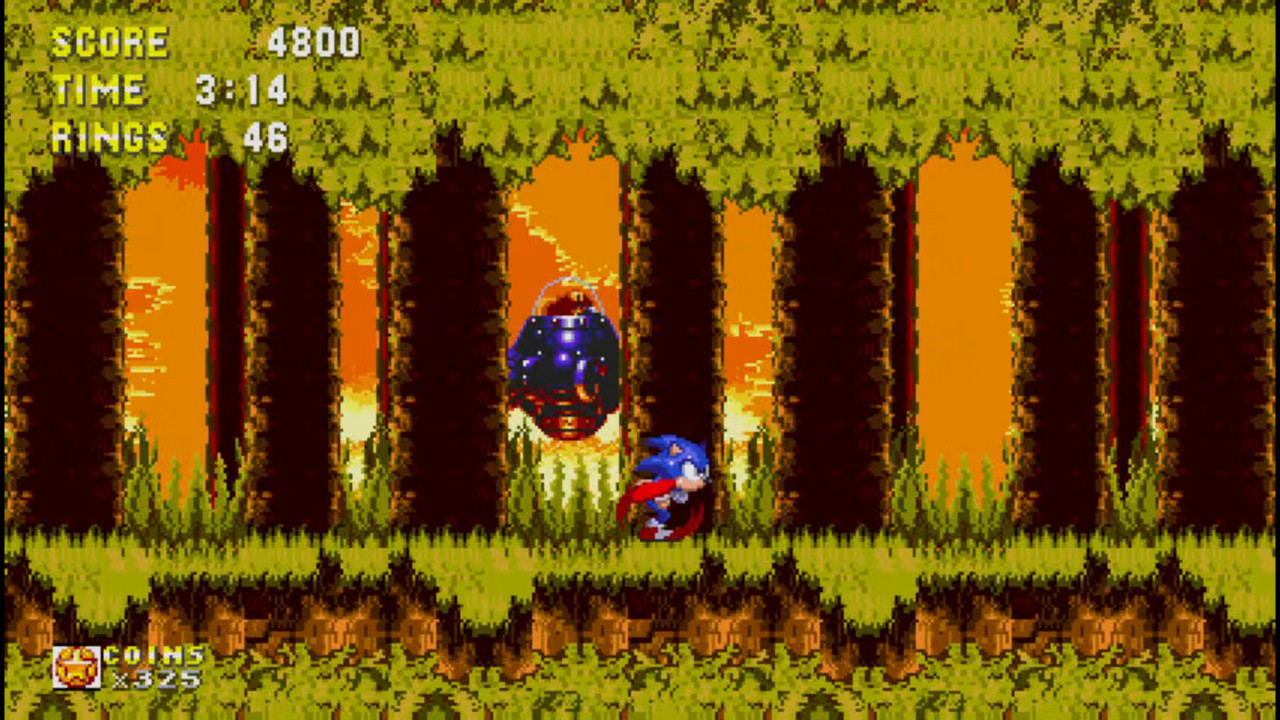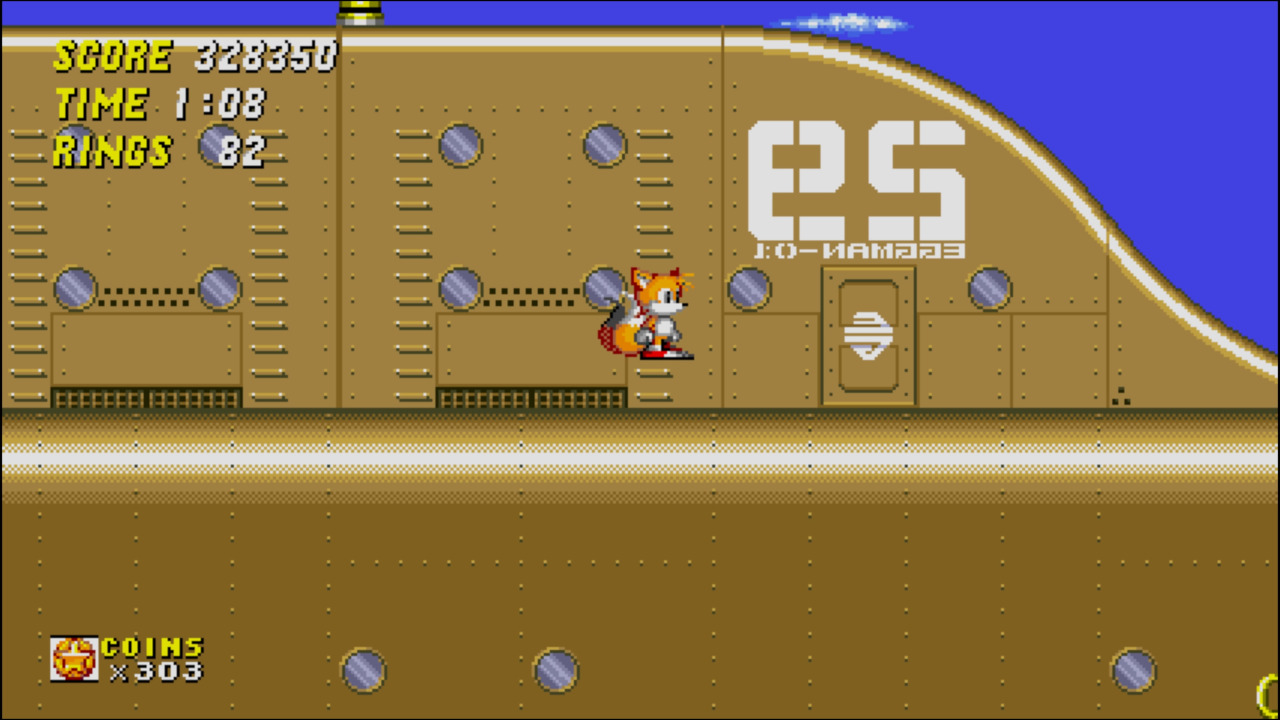Sonic the Hedgehog is an unforgettable, vital franchise in the video gaming zeitgeist. For many, the series represents bold new leaps in gameplay concepts, wonderfully clever level design, and killer soundtracks. It has been 31 years since the first Sonic game, and to commemorate the series’ 30-year mark, Sonic Origins was announced, a compilation of Sonic’s greatest titles from the 16-bit era; Sonic The Hedgehog, and its sequels, Sonic 2, Sonic 3 & Knuckles, and Sonic CD. This is not simply a review of these games, but a review of Sonic Origins as a collection.
This is nothing new, given that these original mainline games have often been collectively assembled in some fashion or another across many different generations, as early as Sonic Jam for the Sega Saturn. But during a generation that’s stagnating with constant remasters and remakes, this game faced the challenge of appealing to new generations of players, as well as promising something for the legions of lifelong fans, so what is it that makes this title different?
What Kind of Game is Sonic Origins?

Ever since the franchise’s inception, the Sonic series has been most often a platformer series, focused on fast-paced level traversal, colorful zone designs, memorable boss fights, as well as just enough of that Sega arcade magic in its score and time attack system. It’s the type of platformer which sparks genuine arguments over which game is the best in the series by its variety of concepts and zones introduced throughout its games, whose contributions appeal to different people for different reasons.
In this platformer you play as Sonic, a cheeky blue hedgehog who is trying to save planet earth (or Mobius depending on how long you’ve been a fan) from Dr. Robotnik or “Eggman” who seeks to capture or outright enslave the planet’s animal inhabitants while trying to harness the power of the chaos emeralds. Sonic is the fastest creature alive in this context, able to race across the numerous biomes and territories, taking down Eggman’s robot army, and face down the villain himself in fun, varied boss fights.
Joining Sonic in Origins are Tails, introduced originally in Sonic the Hedgehog 2, and Knuckles, who was brought around in 3, and each character uses their unique abilities to traverse the level in their way. Enemies are defeated by either jumping into them or using spin dash attacks, and power rings are collected not only to increase your score, but will prevent you from dying if hit (unless you have none left) and grant access to special stages, Super, or even Hyper status. While it might be easy to play off this franchise as self-explanatory, it’s important still to note that this is a wonderful blend of home console fun, and arcade-style challenges.
Gotta Go Fast

Each of the Sonic games has a pretty simple plot that boils down to Eggman hatching (get it?) a scheme where he attempts to steal all the chaos emeralds, or time stones in Sonic CD, trap the world’s animals inside his robot soldiers, and build a massive fortress from which he can carry out his ambitions for world domination. This is a pretty simple high-concept plot, although in Origins it’s assisted by new animated cutscenes which are pretty faithful to the original ones found in Sonic CD, keeping the tone as energetic and cartoonish.
What’s noteworthy about these plots is that, especially in CD and 3 & Knuckles, you see the stakes of the plot become part of the zones you travel across. In CD, there’s the brilliant time travel mechanic, where you can go to the Past and the Future along with revisiting the Present, and if you’ve not collected the time stones (via special stages) by the end of the game, every glimpse you get of the future is the bad one. What this translates to is 4 different, playable periods in the game, each with different visuals and music to accompany them. In Sonic 3 & Knuckles, you encounter Eggman’s ruthless streak on the very first level, where he sets Knuckles’ home, Angel Island, completely ablaze, and despite this, Knuckles is still convinced you’re the intruders and that the fires are meant to smoke you out.
It’s in these moments, as well as simply the appealing challenge of finishing a level as quickly as possible or amassing enough rings to reach a special stage for a shot at chaos emeralds, where you find yourself revisiting the zones throughout these games, mastering their layouts, and being able to fly through them with ease. These still are among the greatest examples of level design and replayability among classic platformers and hold up excellently in the modern era. But what keeps them relevant and a justified purchase in today’s modern console era?
Never Run Away From the Past

It’s no secret that Sonic the Hedgehog has not had the most steady reputation in recent years. The very same spirit of innovation that went into creating the old games, was what caused the ante to keep getting pushed upward without the foresight to know when a new idea might not be a good one. Sonic Origins is a reassessment of these incredibly strong Sonic titles, each with their worthwhile contributions to the formula that was influential and iconic. On top of this, using the Retro Engine created by Christian Whitehead, Origins provides several important quality of life improvements to the compilation, while still providing an opportunity to play the titles in their authentic, original state as an alternative.
One particularly notable change can be found in the form of Anniversary Mode, or Story Mode, which both allow you to play the game in 16:9 format, remastered so more of the screen is visible. This can help with detecting hazards and traversing the screen, although you can still push the engine’s limits in the form of running so fast the screen can’t even keep up, that’s more a testament to how fast you’re truly able to go and how well you’re playing. You’ll also be pleased to see that if you play in these modes, you’ll be able to play as Tails in everything, while Knuckles is unfortunately left out of CD.
Additionally, for those familiar with the Retro Engine like in Sonic Mania, the Drop Dash makes a return, meaning that if you’re playing as Sonic in any of these games, you can make a full jump in the air, tap, and then hold the jump button again until you land, and you’ll be able to instantly spin dash, making movement even more accessible for areas where jumping kills your momentum. This can be a godsend for zones like Chemical Plant, Lava Reef, Marble Zone, and more, allowing you to keep your speed and get your best possible runs.
But ultimately, this is a game for both new players and old fans alike, so the Classic Mode is a welcome option, allowing you to play in a 4:3 aspect ratio, while also keeping the Drop Dash ability out of the equation. This enables different approaches for speedrunning the game or authentic playthroughs. Additionally, for fans of the classic boss fights, there’s a Boss Rush as well as an unlockable Mirror Mode upon successful first playthroughs of each game. Finally, for the fans wanting to comb through as much of the content as possible, there’s a Museum mode complete with unlockable content you can pay with in-game currency (that’s easy to amass) or free content you can unlock throughout your playthrough. So while improvements were added, they had the wisdom to quit while they were ahead.
What’s Way Past Cool About Sonic Origins?

Aside from the massive value proposition of these games being collectively released on PC and home consoles, the gameplay still feels remarkably accessible and fun after 30 years, and the game continues to add to the experience. One fun addition provided by Sonic Origins is the Mission Mode, which crafts challenges using assets from all 4 titles, favoring the fastest completion of each mission and rewarding you with tons of coins, the currency used to buy Museum rewards. The Mission Mode challenges are almost all quite easy, but they present an interesting notion – if these assets can be rearranged in such a clever fashion and make for entertaining new levels, what’s to stop Sonic Team and Christian Whitehead from making a Sonic Maker?
Also, while it’s almost ridiculously easy to complete the achievements of this game, that’s due in large part to how fun it is to play as much of the game over and over to 100% everything. Getting the good ending is far too tantalizing, and the games make a point of mocking you for not getting all the chaos emeralds if you don’t. Sonic CD constantly reminds you of the bad future that lies ahead if you don’t complete the game, and in some cases, entire stages are unavailable making for a less full experience.
Another noteworthy element is how worthwhile it is to play as the different characters. While the gameplay isn’t as sophisticated as more recent platformers and how their characters have a whole array of functions, Sonic’s insta-shield from Sonic 3, Tails’ limited flight mechanics, or Knuckles’ ability to glide and climb walls allow you to experience the zones in entirely different ways. Oftentimes Sonic’s methods are the fastest, but any of the 3 are often simply fun to experience.
The Visuals

While the aspect ratios were discussed earlier, the game is in full HD with options to play in either 4:3 or 16:9 mode but does not appear to feature a CRT mode for those wishing to have the original scanlines visible. Not a huge loss, given the vibrant colors of the Sega Genesis and CD, which are brought to even greater life on HD consoles, and the parallax scrolling that tied together with the world around these massive zones and helped establish just how far you were traveling. Many of the most striking visuals were found in the varied level design of Sonic 2, the variety of animations and fluidity of motion in Sonic CD, and the way the world would transform in front of the players in Sonic 3 & Knuckles.
But it should be noted just how creative and different many of the character sprites and enemy designs were, with a particular note for the protagonists and Eggman. Sonic is the cocky speedster, whose eyes communicate mischief and bravado to the player; Tails is smaller in stature and more gentle, presenting an almost meek but excited facade; Knuckles is the tough guy, annoyed when you’re in his way, and ready to laugh at you when he’s got you at his mercy. Eggman, the antagonist, despite not showing his eyes, is wonderfully animated to show a desperate, comical evil genius archetype who consistently flees from danger but will relish every opportunity to laugh as you perish should you die in a fight against him.
Finally, the bosses and the inspired designs behind them are truly noteworthy. Despite most bosses being Eggman, if not his legion of badniks (robots), there are so many different, interesting fights to experience in Sonic Origins, and the Boss Rush is a fantastic way to sample them. There are less noteworthy ones like the first iteration of Mecha Sonic in Sonic 2, but often they get outweighed by brilliant ones like the Metal Sonic chase across Stardust Speedway in Sonic CD, Eggman at Lava Reef, or the chase at the end of Labyrinth Zone which becomes the fight in itself. Sometimes it’s less of a case of how quickly you can hit the enemy enough times to win, and the game is all the better for just how often it pulls this off.
The Sound

Oh, the sound. Sonic as a franchise will forever have incredibly memorable tracks, popular for the endless potential for remixes thanks to the wonderful groundwork laid down by that Genesis thanks to the Yamaha YM2612 sound chip. Most of the music is preserved at the level to which we are accustomed, although with some unfortunate tweaks. The music is an absolute treat and helps keep the energy alive for so many levels, most notably in tracks such as Chemical Plant, Spring Yard Zone, Hydro City, Flying Battery, and Stardust Speedway. The best part is that, in the case of Sonic CD and Sonic 3 & Knuckles, the music has multiple variants per level, such as the excellent key and mood change for Angel Island Act 2.
The rest of the sound design is excellent as well, and so many sound effects are still quite iconic, such as when you gather rings, gain an extra life, or beat an enemy. There’s also a great deal of feedback in the form of how responsive the sound is to how you play – spin dashes are satisfying to hear and an immediate indicator of your speed boost, jumping is satisfying, and when a platform is about to give way, you’ll hear it. Much of the sound design is familiar territory with many Sonic players at this point, but it still warrants mentioning just how strong of an experience everything from the music down to the sound of you getting a checkpoint is for making a satisfying experience.
One particular, fascinating problem that fans will surely groan about for the release of Sonic Origins, is the change to the music for Sonic 3 & Knuckles. The specifics are still not fully established, but the story goes that Michael Jackson was involved in the music for the original release, but as soon as allegations of his abuses were made public, Sega cut off Jackson’s team’s involvement. As a result, tracks such as Carnival Night and Ice Cap will be noticeably different tracks altogether, with the former being essentially what was used for the original PC release. Not bad, but different, which in the eyes of some fans, is just a subgenre of bad.
The Issues

Sonic Origins is not without its issues. Most are simply cosmetic, some are mundane (it’d be nice to have even more Sonic games from the era, but the crucial ones are there) but there are a few that persisted since the original releases. None of these games are plagued with issues, per se, but some have a couple of bugs that never got worked out, and if it weren’t for the Drop Dash mechanic, some of the zones would be marginally less enjoyable to re-experience.
On the genuine design oversight side of things, there are very few issues that come to mind but simply bear mentioning for the sake of awareness that these games are hardly perfect, and that zones of these sizes can still have blind spots. Wing Fortress from Sonic 2, and Carnival Night from Sonic 3, are classic examples of this, in which you can in very rare circumstances, soft lock yourself, meaning you’re trapped in an area where you can’t otherwise simply die and return to a checkpoint, but wait out the timer. These were infuriating issues, but mercifully rare to experience, and thanks to the understated autosave mechanic, you can even quit the game but still return to your last checkpoint. It’s annoying that the soft locks are still possible, but they won’t break the game for you.
Some level designs haven’t aged as well as others, and sometimes the developers threw in mechanics that were, for many players, very difficult to figure out. Marble Zone from Sonic 1 hasn’t aged particularly well because, despite being one of the earlier zones in the game, it immediately shuts down most of Sonic’s momentum, although if you play on Anniversary Mode, you can use the Drop Dash to help preserve some of that. Additionally, the Spinning Wheel featured in Carnival Night, while a fun platforming gimmick, quietly includes a feature where you must press Up and Down on the D-Pad for it to move, but there’s no indication that is what you are supposed to do, and there’s a crucial point you must get past only once you realize this mechanic exists.
The Verdict

Sonic Origins is an essential collection not only for any franchise fan with current or last-gen gaming hardware but also for anybody who appreciates tight gameplay with a banger soundtrack. Sonic is the ultimate “Animal With an Attitude” mascot still having major games released to this day, and while the franchise has had a tarnished reputation due to sub-par releases lately, it remains plucky and pushes forward, never losing sight of its roots. The franchise, for good and bad, never rests on its laurels but strives to innovate and push the games, and medium, to greater heights, and this collection is a perfect encapsulation of that vision.
This game is an example of work by adoring fans such as Whitehead, who, thanks to their vision and dedication to preserving the strongest elements of Sonic’s classic days, can bring it to modern audiences with wonderful accessibility. It’s also an example of Sega’s adoration of its legacy and serves as an exemplar for a tasteful, faithful remaster which still manages to add to itself in charming and thoughtful ways, to keep players coming back for more.












Published: Jun 21, 2022 07:59 am